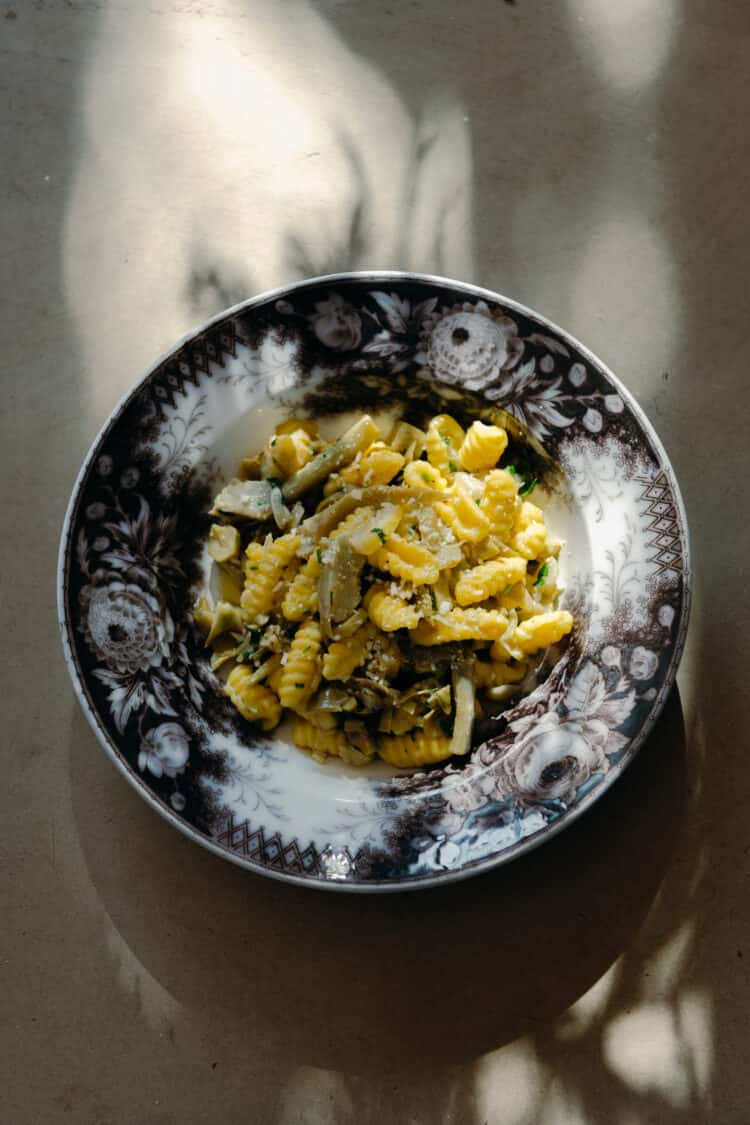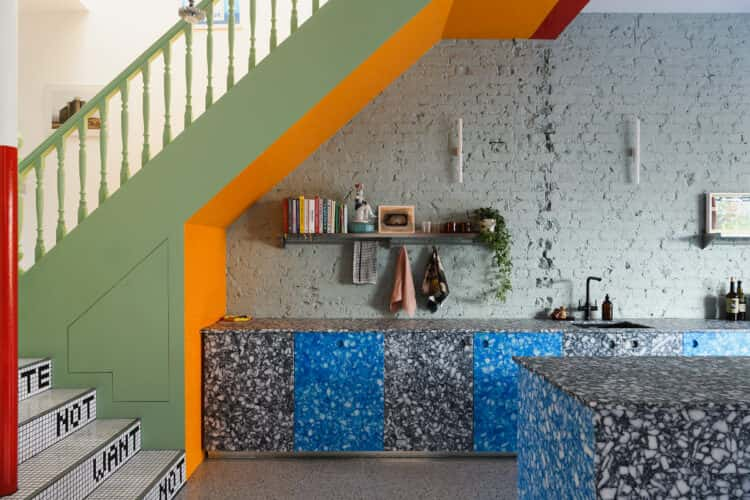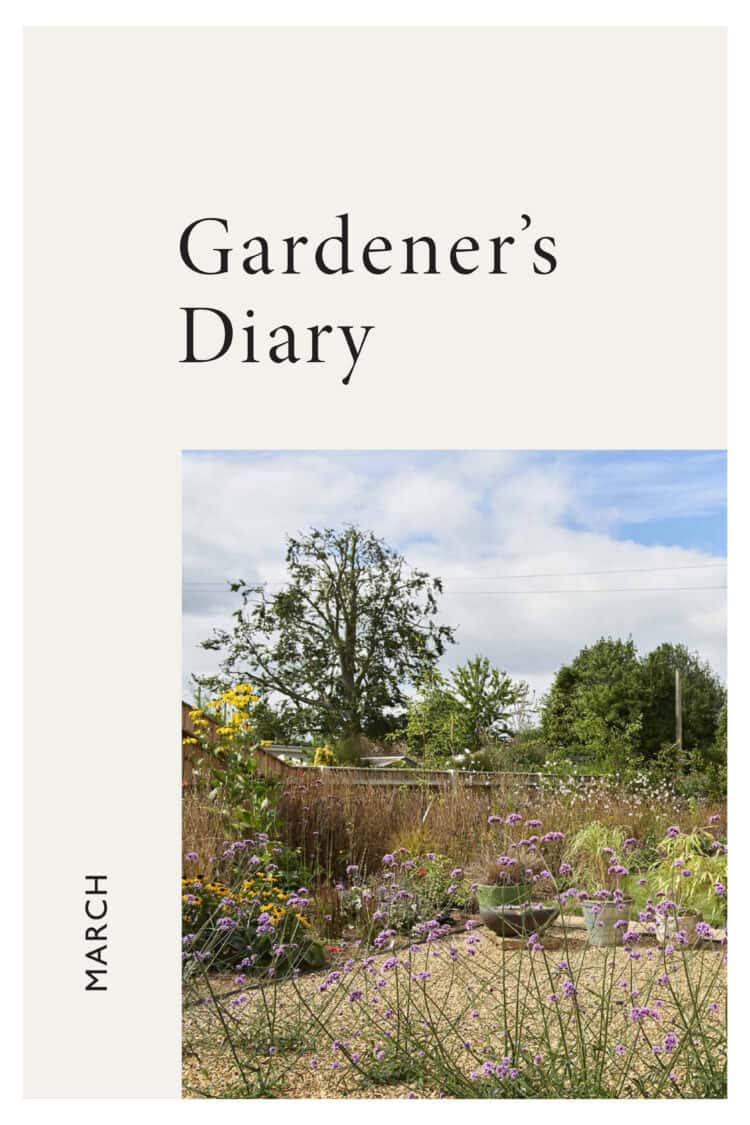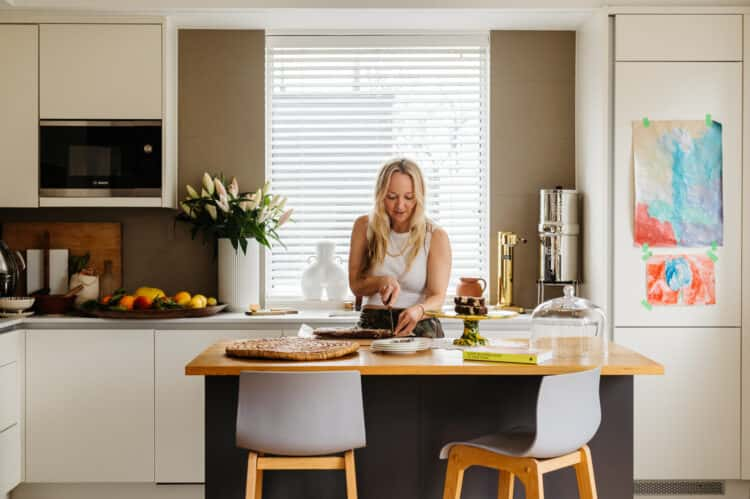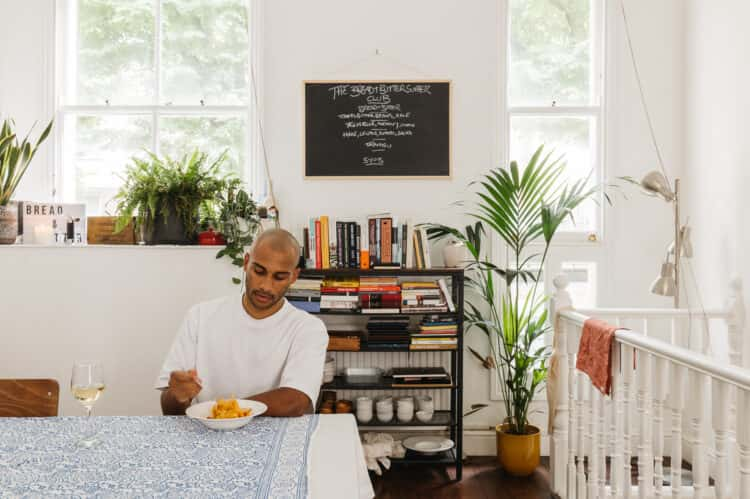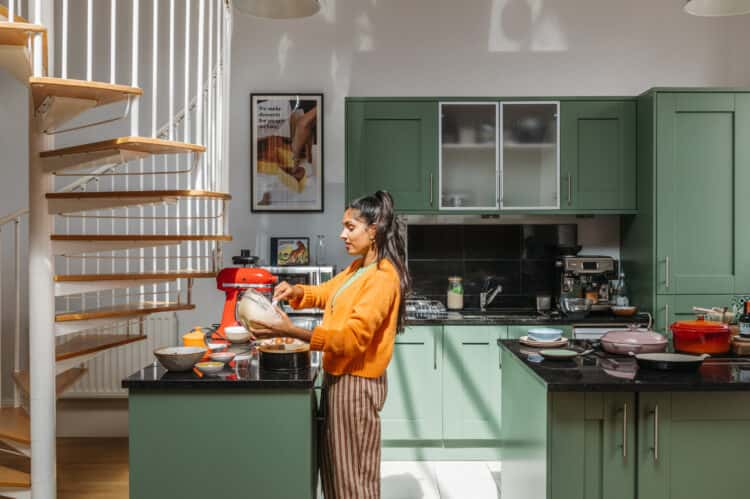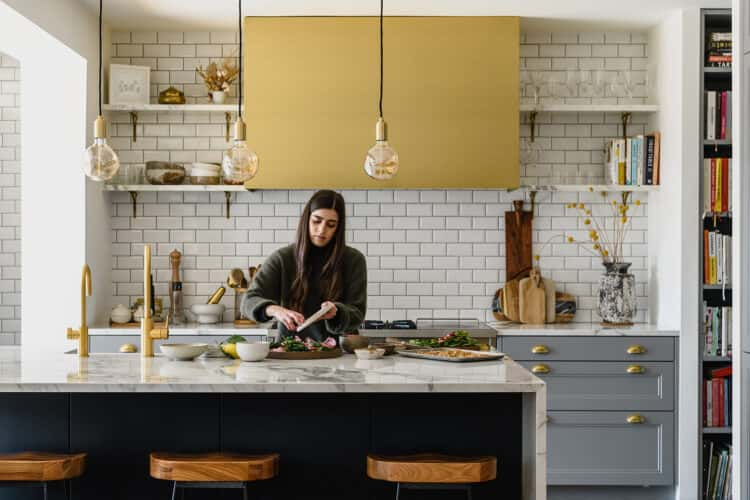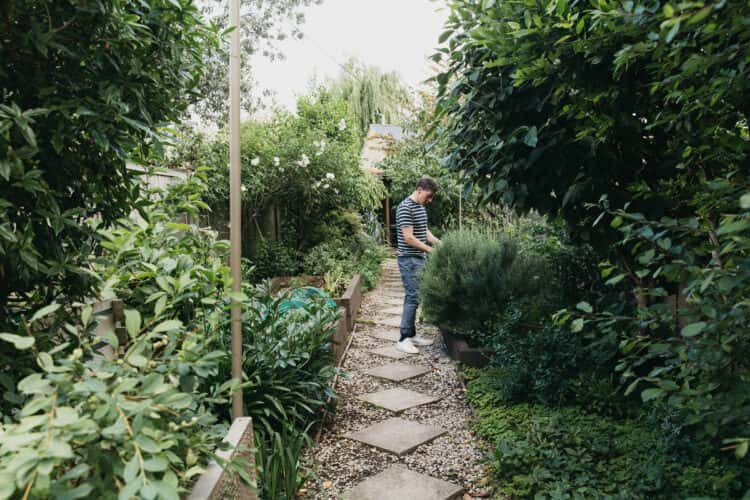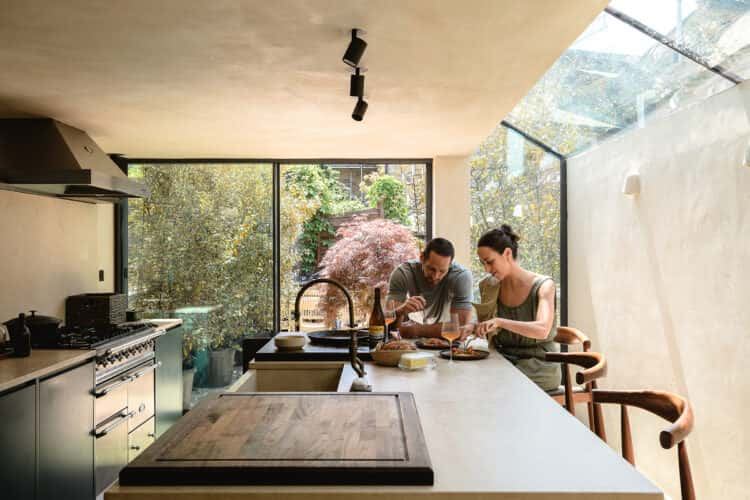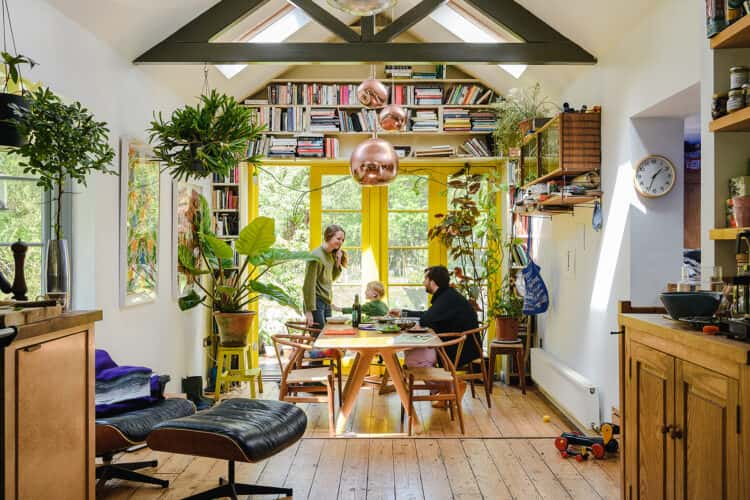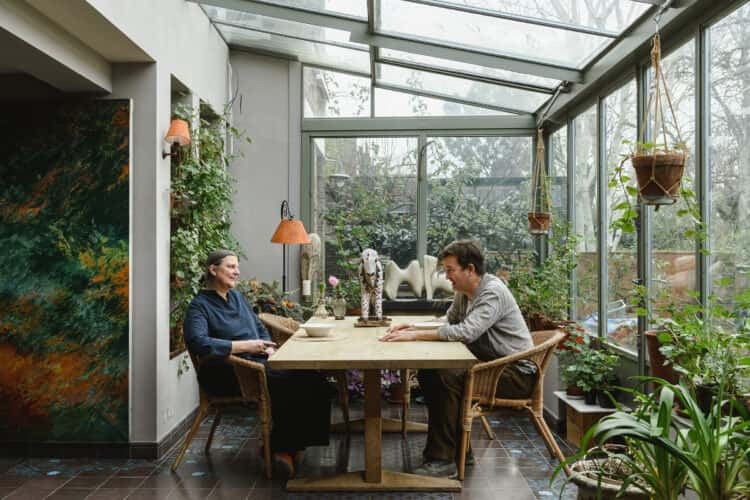Chefs at Home: Bocca di Lupo founder Jacob Kenedy on the joys of seasonal cooking at his home in Angel, plus a recipe for artichoke malloreddus
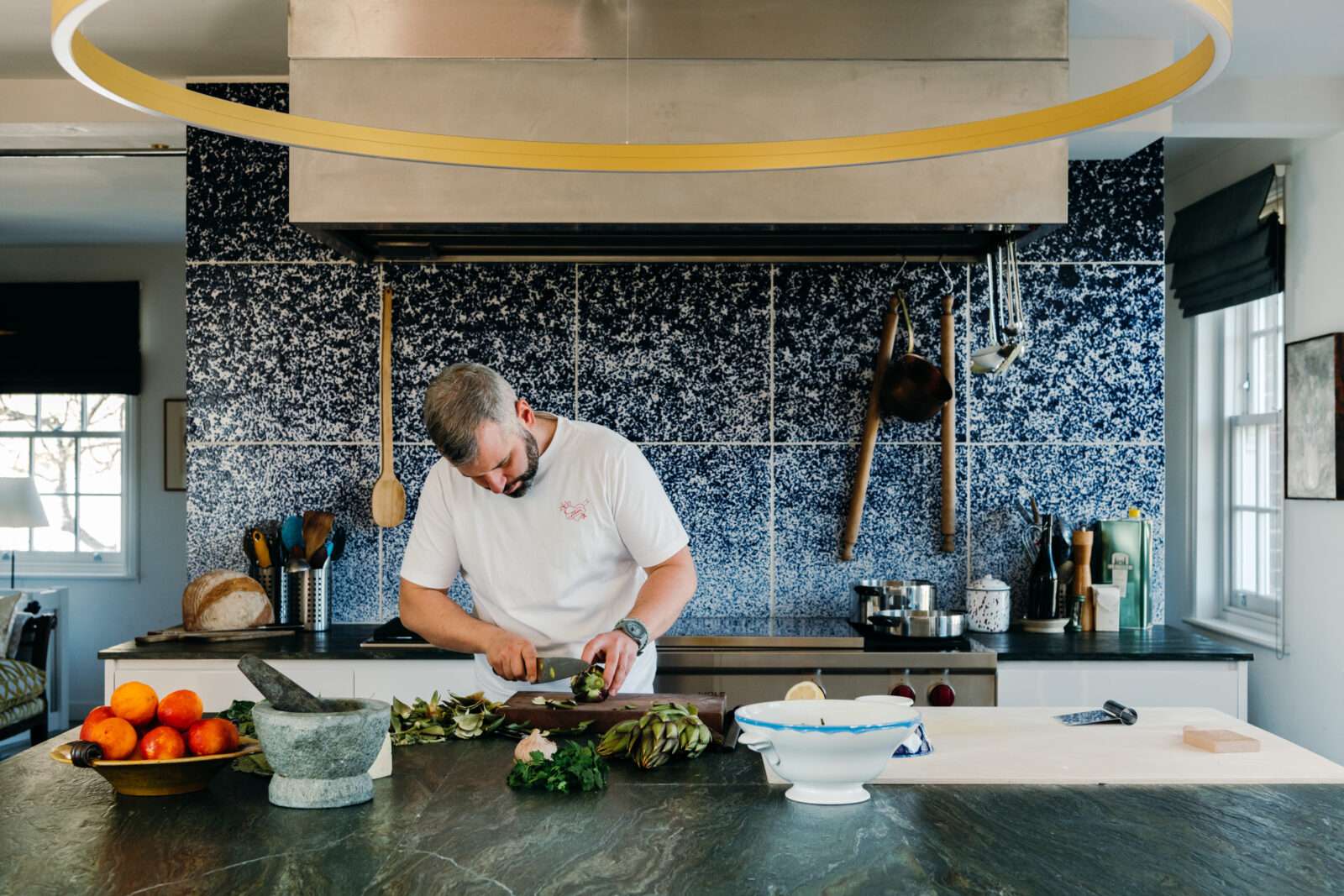
Jacob is best known for the regional Italian dishes he serves up at Bocca di Lupo in Soho – from salt-baked bream and grilled treviso to unctuous plates of pappardelle with beef stracotto. He’s also the brains behind Soho ice cream parlour Gelupo (go immediately if you haven’t been already), as well as Angel’s Plaquemine Lock where he serves up Creole and Cajun cuisine. Here, over lunch with his mum, artist Haidee Becker, he shares his love for his weekly trip to the farmers’ market and tells us why his son is his harshest food critic.
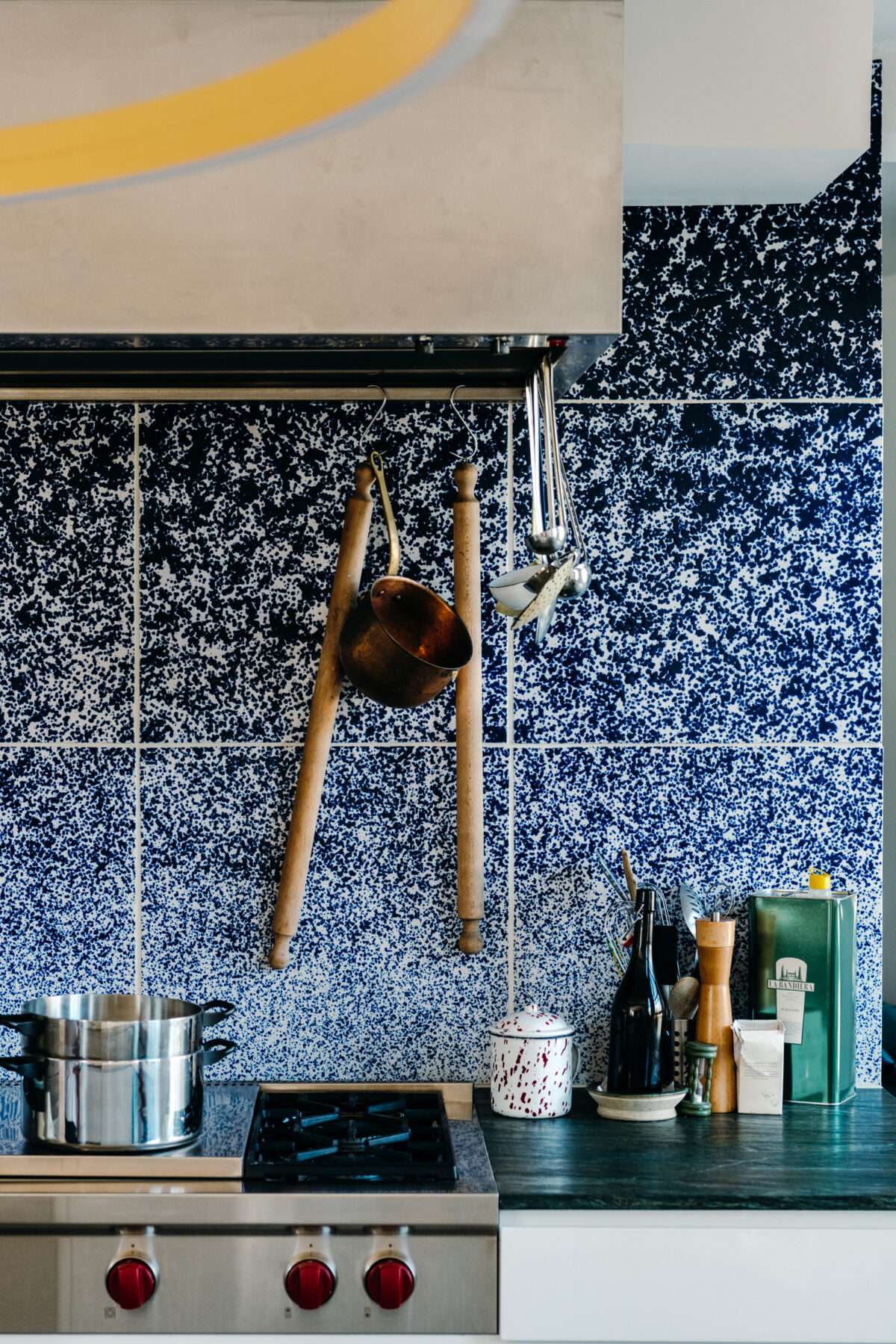
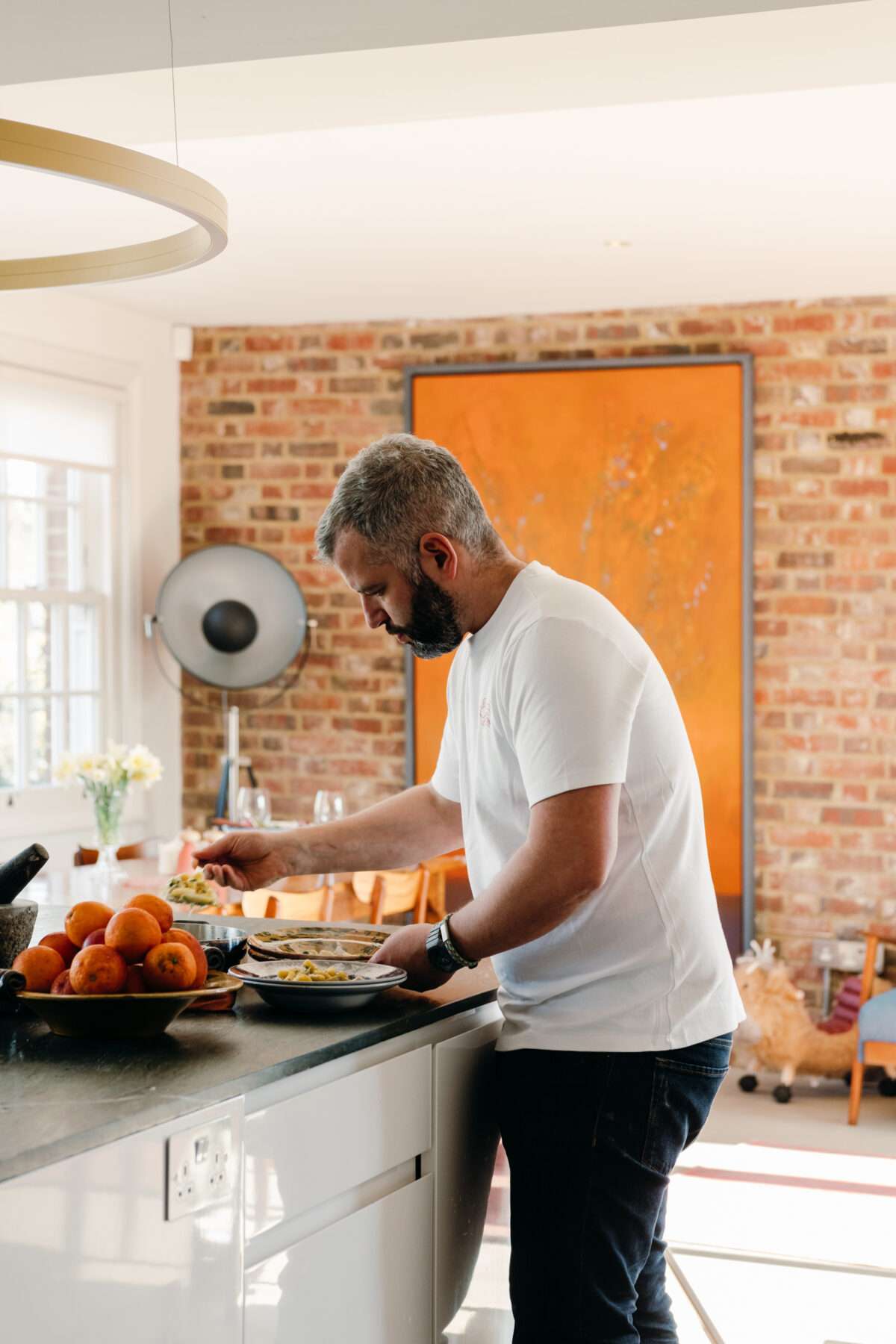
Jacob: “This kitchen is designed to be the centre of our home. For us, it’s the space where all the action happens and where our friends congregate, so we decided to put it in the middle of our flat. Our home is spread across the first and second floors of a mixed-use building, and we basically had the scope to completely change the footprint of the space. We worked with architect Kampanat Atichatpong to configure the rooms exactly as we wished. Cooking is central to my life, as I think it should be to every home.
“I’m quite a messy cook, which I thought I could solve by incorporating plenty of work surfaces into the kitchen. We have a two-metre square island in the middle and then two rows of units. It does make cooking a lot more pleasant when you have space, but I now just spread across all of the surfaces and end up with more mess to clean up. Pots, pans and bowls are all stashed in units and drawers underneath the worktops, as we don’t really have many walls for higher units. It means the space has a wonderful, open feel, and there is more space to hang art. Most of the pieces are by my mum, Haidee Becker.
“In some ways, our kitchen isn’t that different from a commercial kitchen, but there’s a lot less stuff and it’s quieter. I do have two ovens though, which is a real luxury.
“The splashback of bold blue tiles on the wall behind the hob is pretty epic. It’s completely tailored to the space and the tiles were made by a British company called Darwen Terracotta, which specialises in faience tiles. The same company did the tiled cladding on the building’s exterior, which is how we ended up using them in the kitchen.
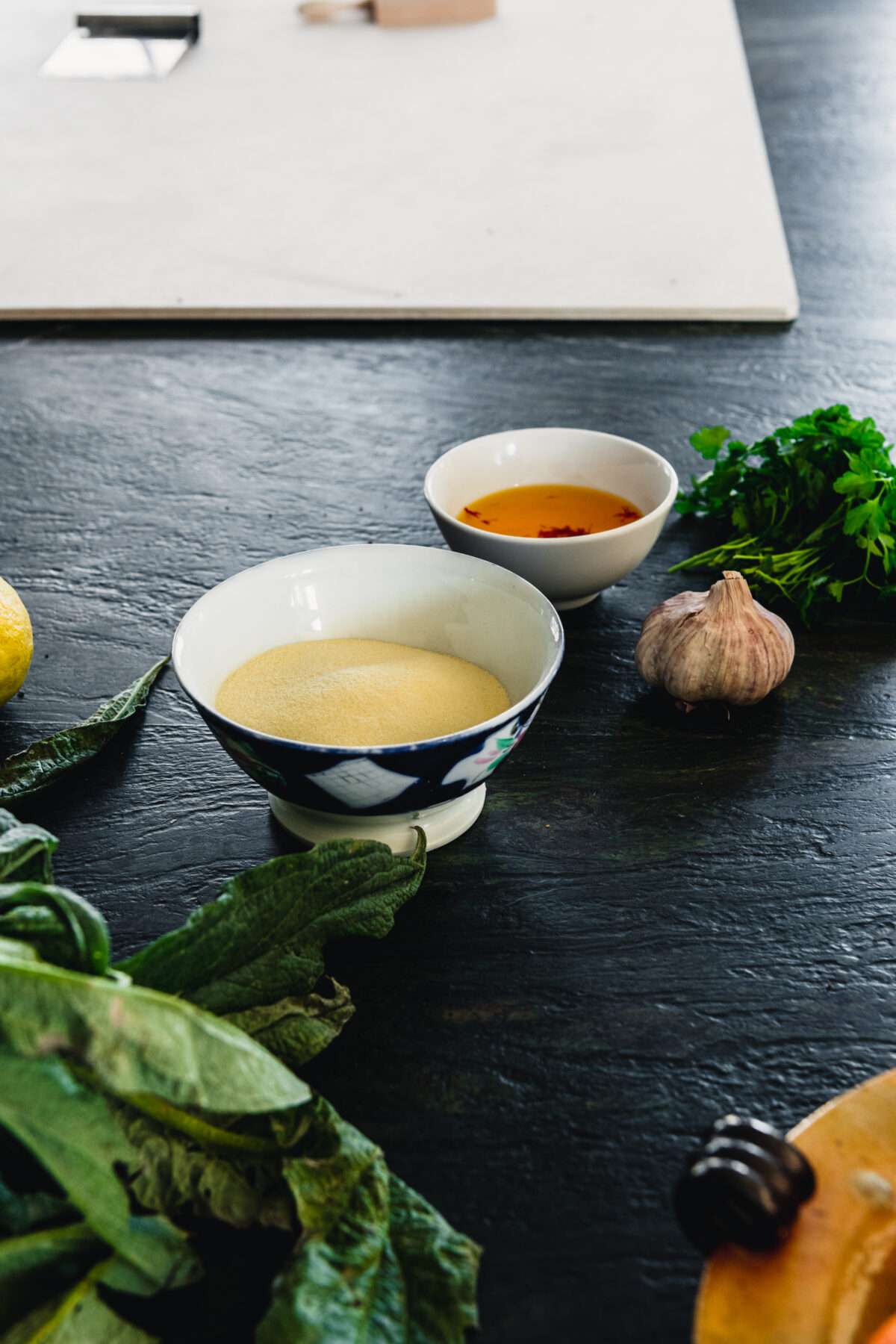
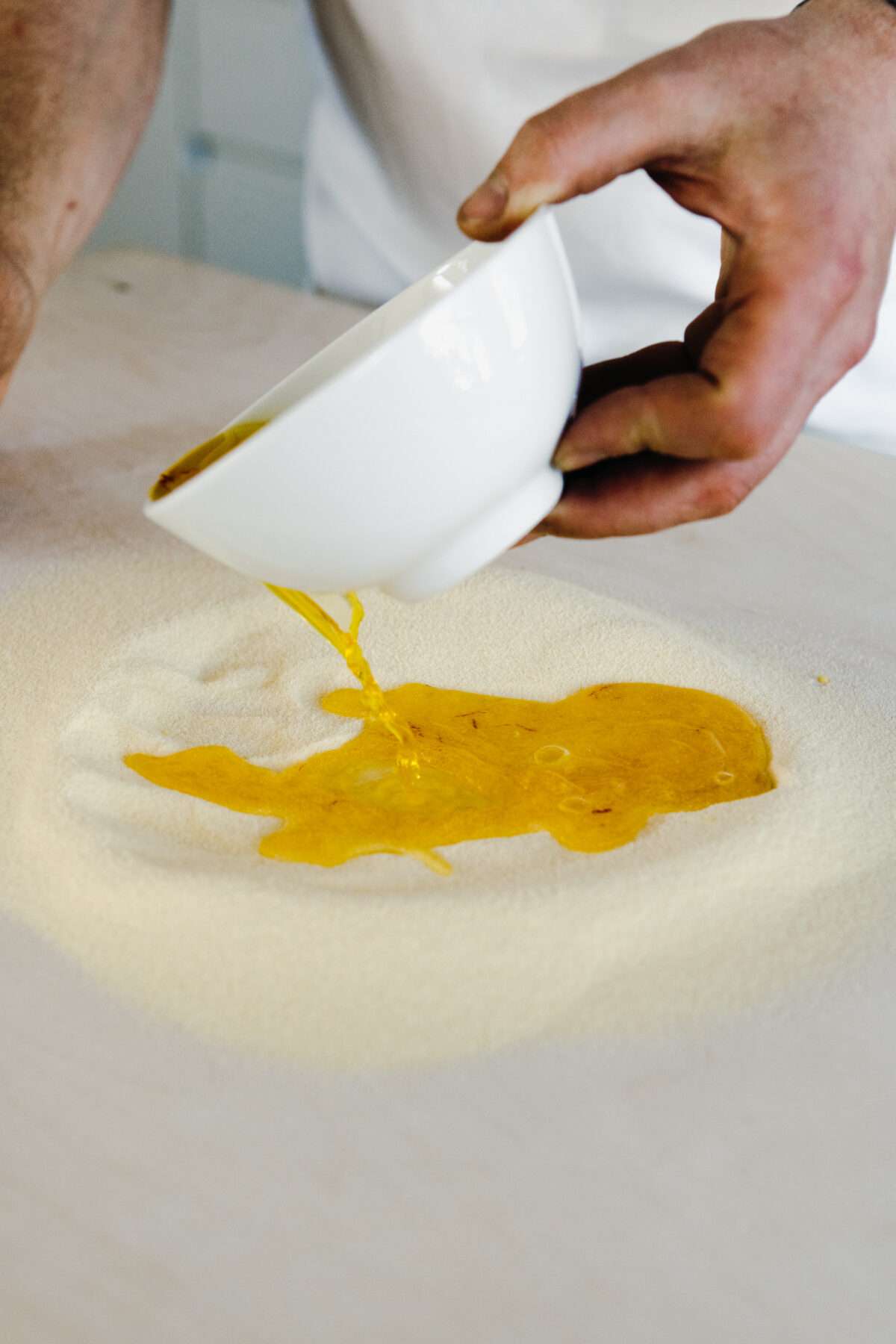
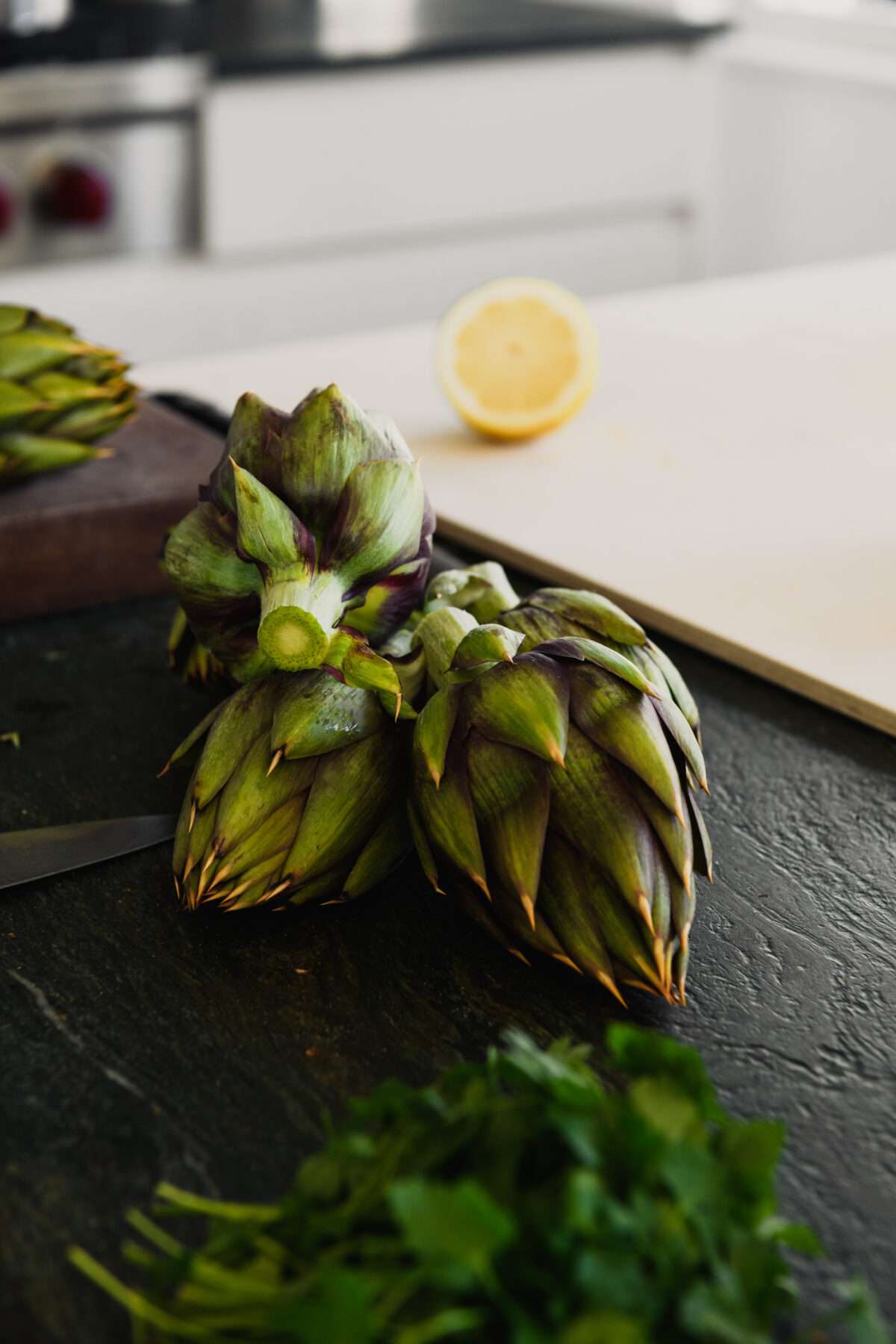
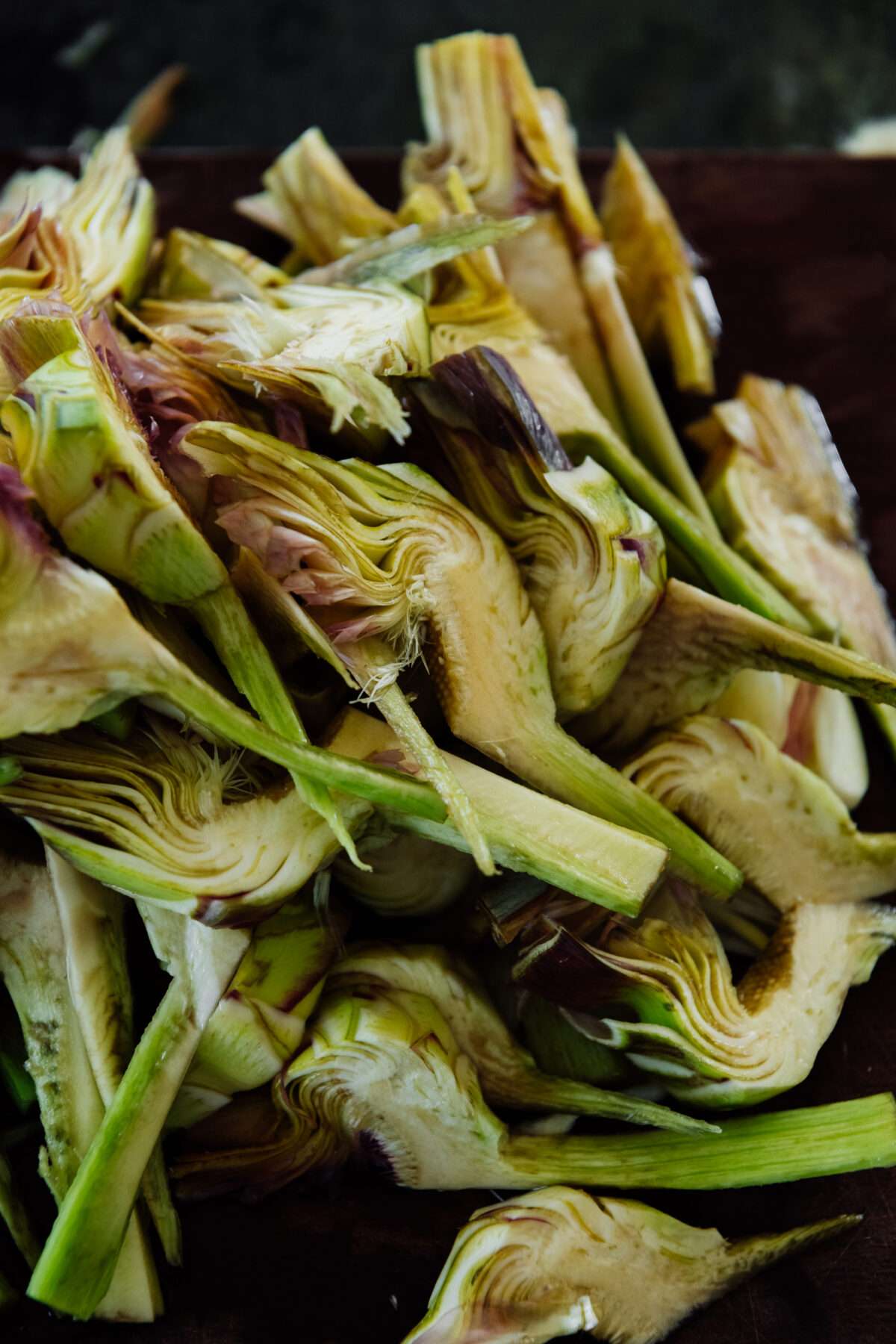
“My most cherished kitchen tools are my stovetop coffee pot and my collection of knives.
“Putting my Alessi Moka Pot on the stove is part of my morning ritual, as it makes delicious coffee. I’ve also got another one from 9Barista, which my friend who’s an engineer designed, and it makes a small, very accurate espresso. Coffee has become very important to me; especially now we have an 18-month-old.
“Over my 20 years as a chef, I’ve collected knives and each one brings back memories. I’ve got a lovely Victorinox Chef’s knife with a cherrywood handle, which I bought when I started working at Moro in 1998. I’ve got another identical one, which I bought when I was working in America, as it was cheaper to buy a new one than ship my original one over. I like old things and nothing in my kitchen really matches anything. It’s all a hodgepodge.
“Another bit of kit I love is my spiral breadbasket. I bake a loaf of sourdough once a week or so, and this basket has seen lots of loaves. It wasn’t expensive to start with, but the more battered it gets, the more valuable it is to me.
“The cookbooks I refer to most are the Moro cookbooks by Sam and Sam Clark and anything by Claudia Roden or Fergus Henderson.
“Patience Gray’s Honey from a Weed: Fasting and Feasting in Tuscany, Catalonia, the Cyclades and Apulia is perhaps one of my favourite cookbooks, which I was introduced to when I started working at Moro. It tells the tale of human history, as well as the connection of man to land.
“Another one I return to often is Science in the Kitchen and the Art of Eating Well by Pellegrino Artusi, which was first published in 1891. The title says it all, really and it’s such a seminal book that is filled with great recipes. It entered my life in late 2007 when I was starting to think about setting up Bocca di Lupo and thinking about Italian food. I started looking into its history and trying to understand it rather than just seeing it as a type of cuisine.
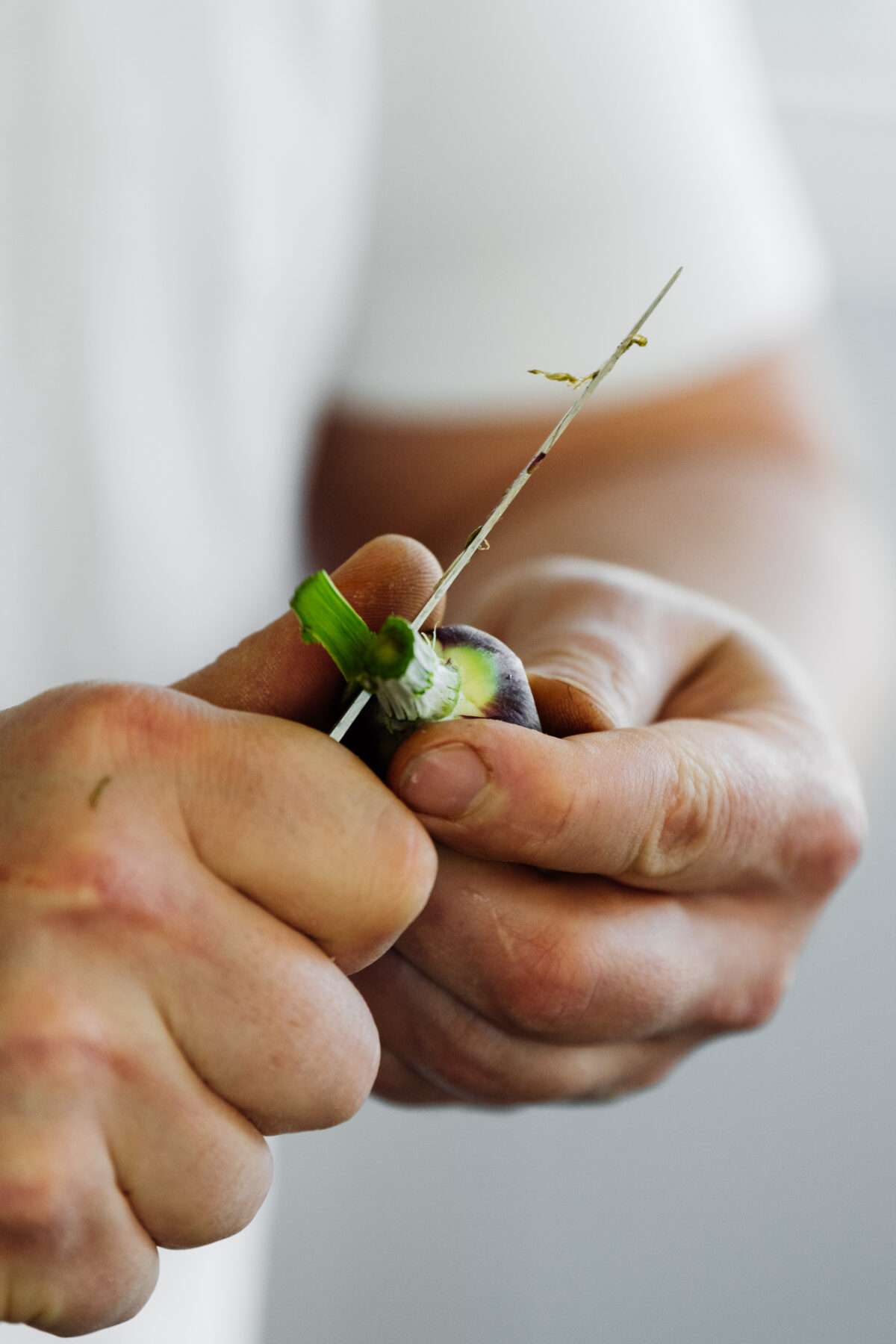
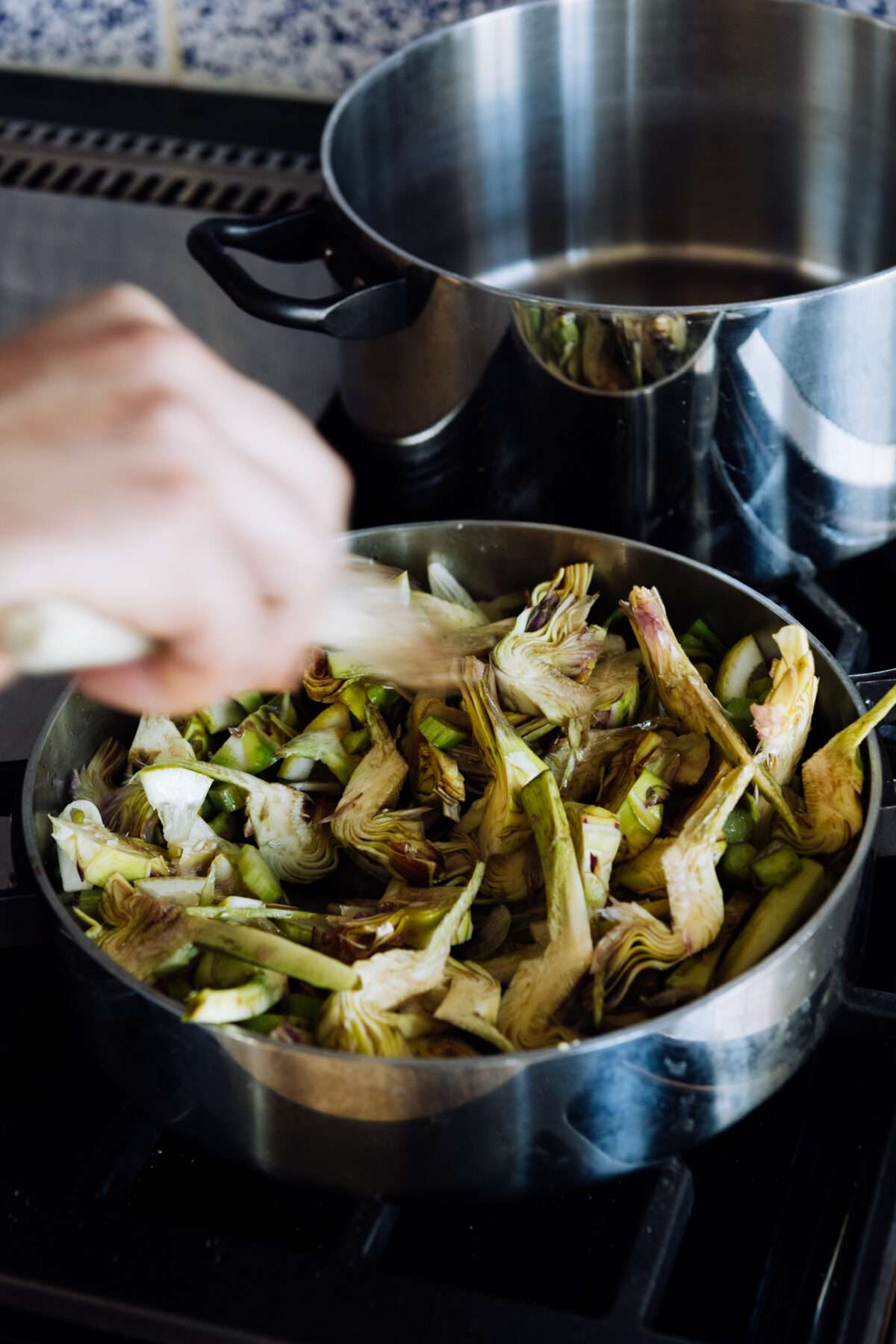
“My approach to home cooking embraces a bit of everything. We cook a fair bit of Italian food, as well as Middle Eastern food, Chinese and Thai, and I love experimenting with Ethiopian food.
“I tend to split the cooking with my husband. One of us will always have a bit more time in the week to cook, but we try and cook a few meals together too. With two restaurants to run, I don’t get to cook very much at work, so I always find cooking at home a very joyful experience. If I’m cooking Italian at home, we’ll pretty much eat the same food that we serve in Bocca di Lupo, where the emphasis is on regional Italian dishes. Sometimes it’s as good as the restaurant food, but sometimes not.
“Since the birth of our son, Dylan, we’ve become a bit more conscious about what we eat and we try to make sure there’s something on his plate that he will enjoy. We put a bit less chilli in things and eat a lot more gnocchi and short pasta, as it’s much easier to manage than spaghetti! Nothing compares to the feeling of putting a plate of food down for him and him actually eating it. He’s my harshest critic.
“A classic weekday meal here looks like the bounty gathered from visits to small local shops – I have two great fishmongers and two great butchers on my doorstep, a weekly local farmer’s market and, en route to my home office in my mum’s garden shed, I walk past cheesemongers, greengrocers and bakers, while hurrying back in time for supper. We try to eat before 6pm now, so that we can share our meal with Dylan. It’s important to me that we all sit around the table and enjoy food together.
“We roast a chicken most Mondays, which we buy from our very good local farmer’s market in Angel. As it gets warmer, we’ll spatchcock it and do it on the BBQ instead. We eat quite a lot of fish and seafood – mussels and clams by the bucketload, probably one whole fish a week (a nice bream or bass or something), and a cut of a larger fish (salmon or hake tail, ray wing, etc) on another day.
“We have pasta at least a couple of times a week – ravioli with butter and sage, or pasta with pesto or tomato sauce. I really believe that any dish done properly, with good ingredients, can be the best dish in the world – but nonetheless, these sauces became the archetypes of Italian cuisine for a reason. Every meal comes with a leafy salad, an appetite I inherited from my mum, and fewer finish with dessert than I’d expect.
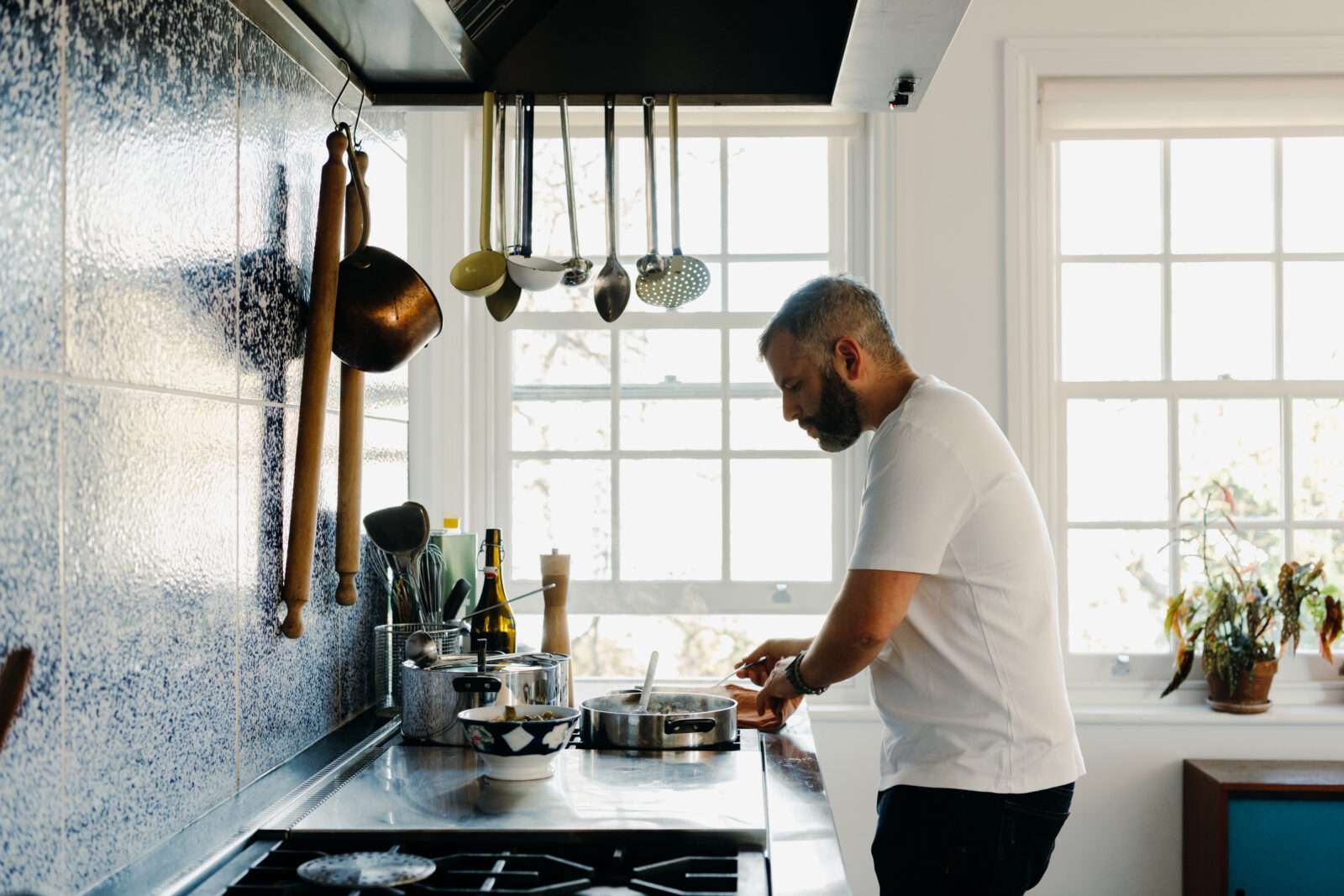
“At the weekend we like to go to the Sunday farmers’ market in Angel and stock up on vegetables to last us for the week. It has incredible produce, and I buy an inordinate amount of vegetables, which often means that by the following Friday and Saturday, I’m desperately trying to use them all up. I’ll often end up doing a very green frittata with all the vegetables that I thought we’d have got through in the week.
“Bocca di Lupo is open seven days a week, so – when it’s not lockdown – it’s never that obvious to me when it’s the weekend.
“Most of my favourite memories are the little things, like the smile on Dylan’s face when I gave him his first pancake. We cook pancakes on a random indeterminate day of the week and it’s always a popular day.
“My fondest memory in this kitchen is when we introduced our son to our friends and family. He’s been around for half as long as the kitchen.
“I love having small gatherings – just us and one other couple is ideal. For me, it’s important to spend proper time with fewer people.”
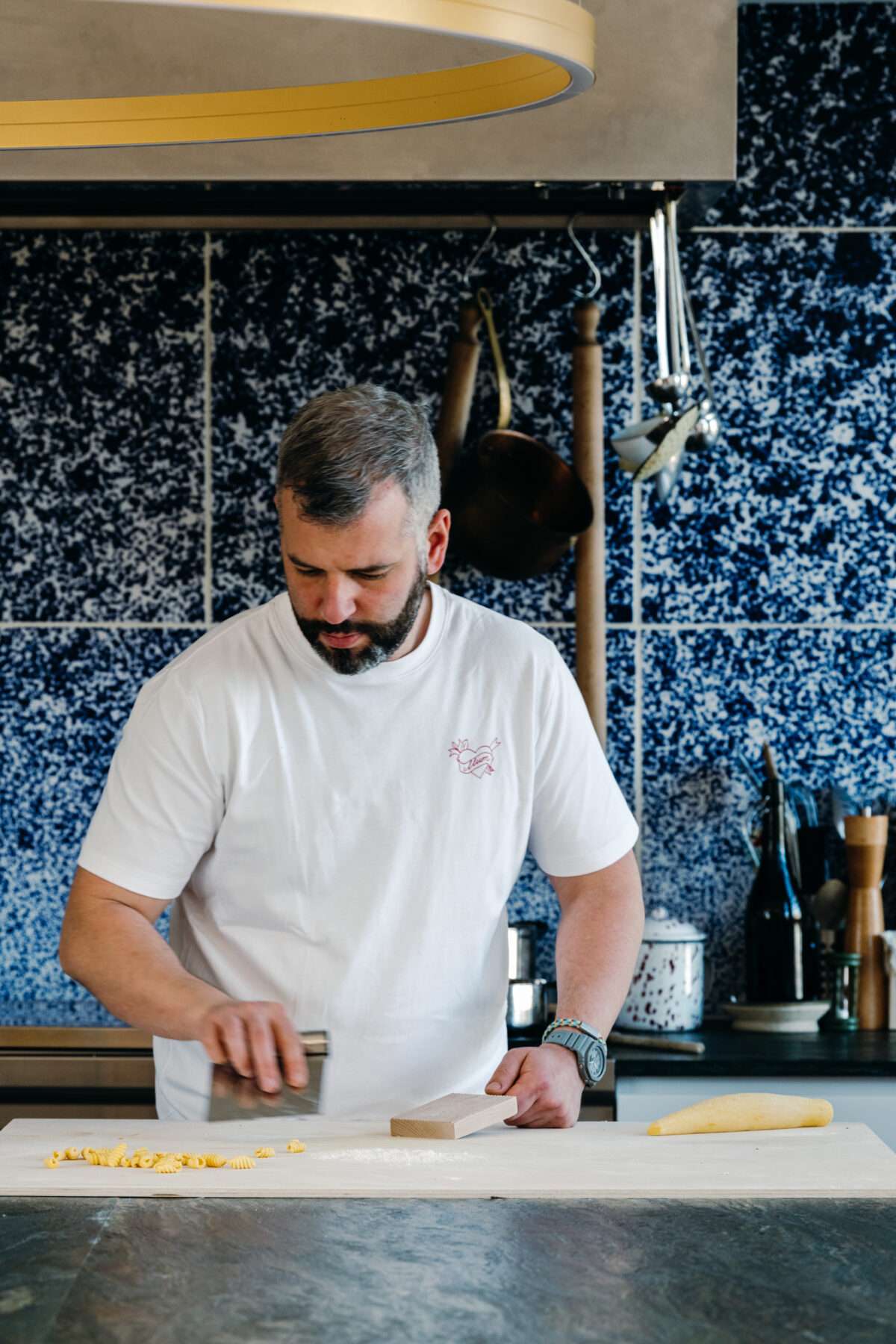
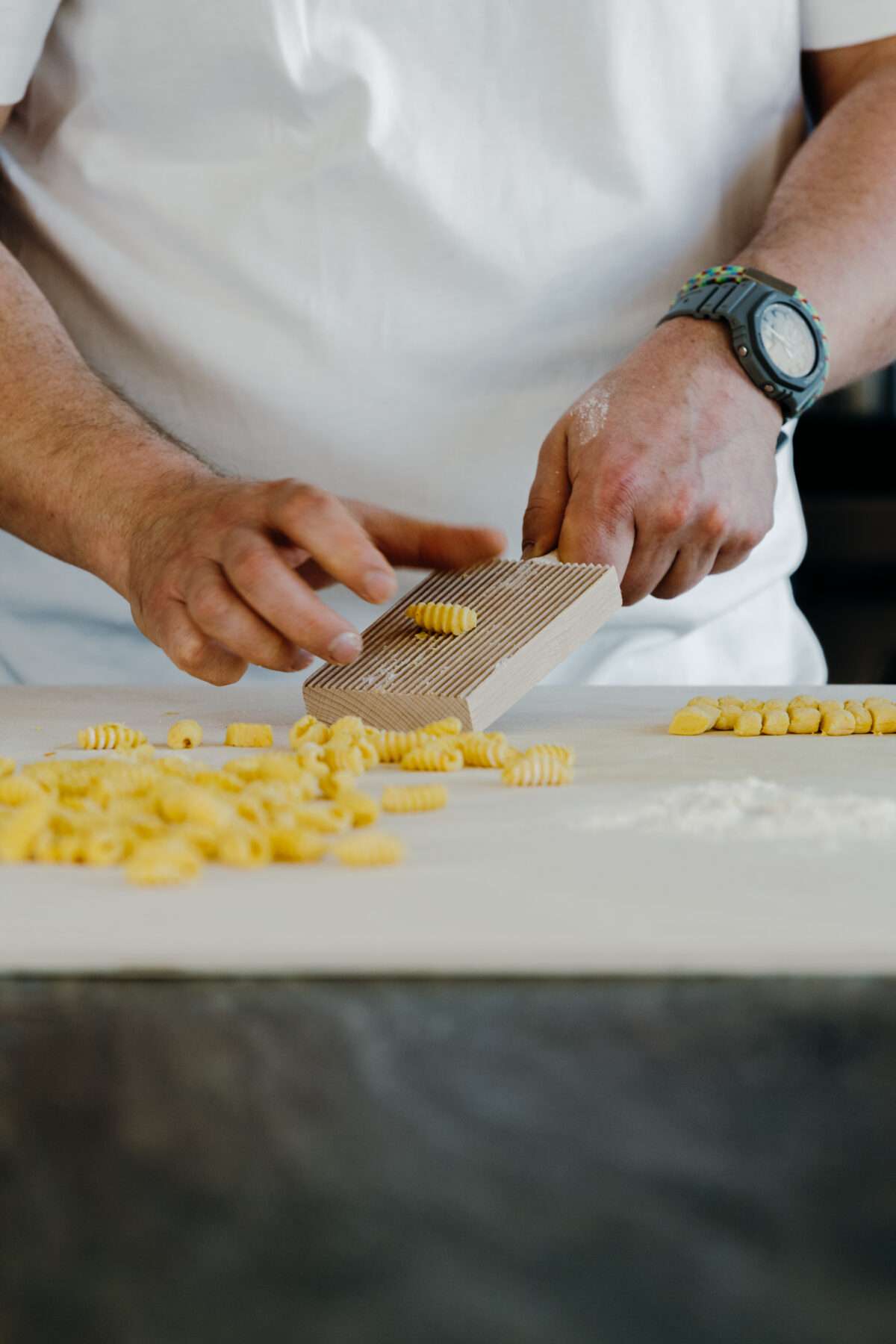
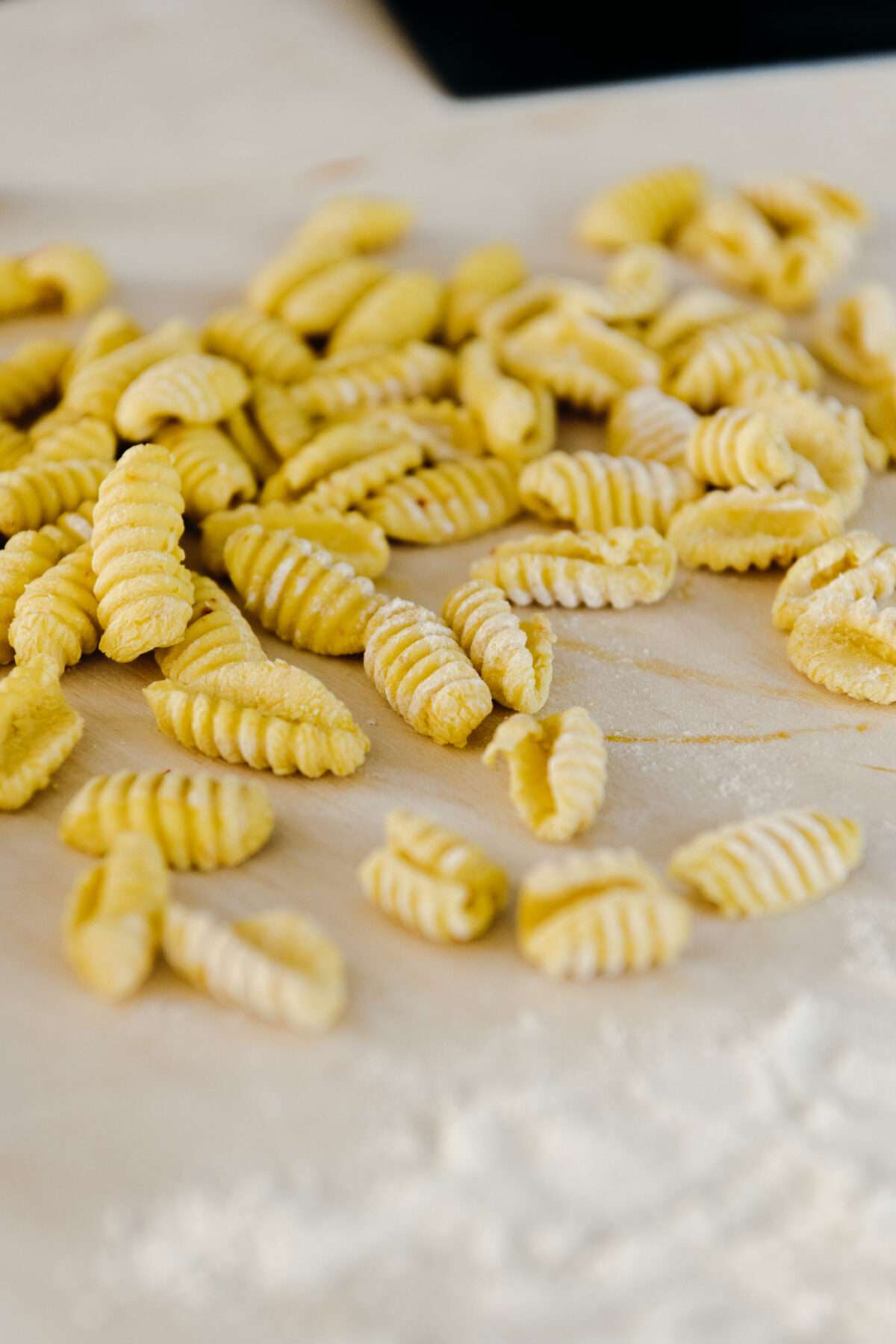
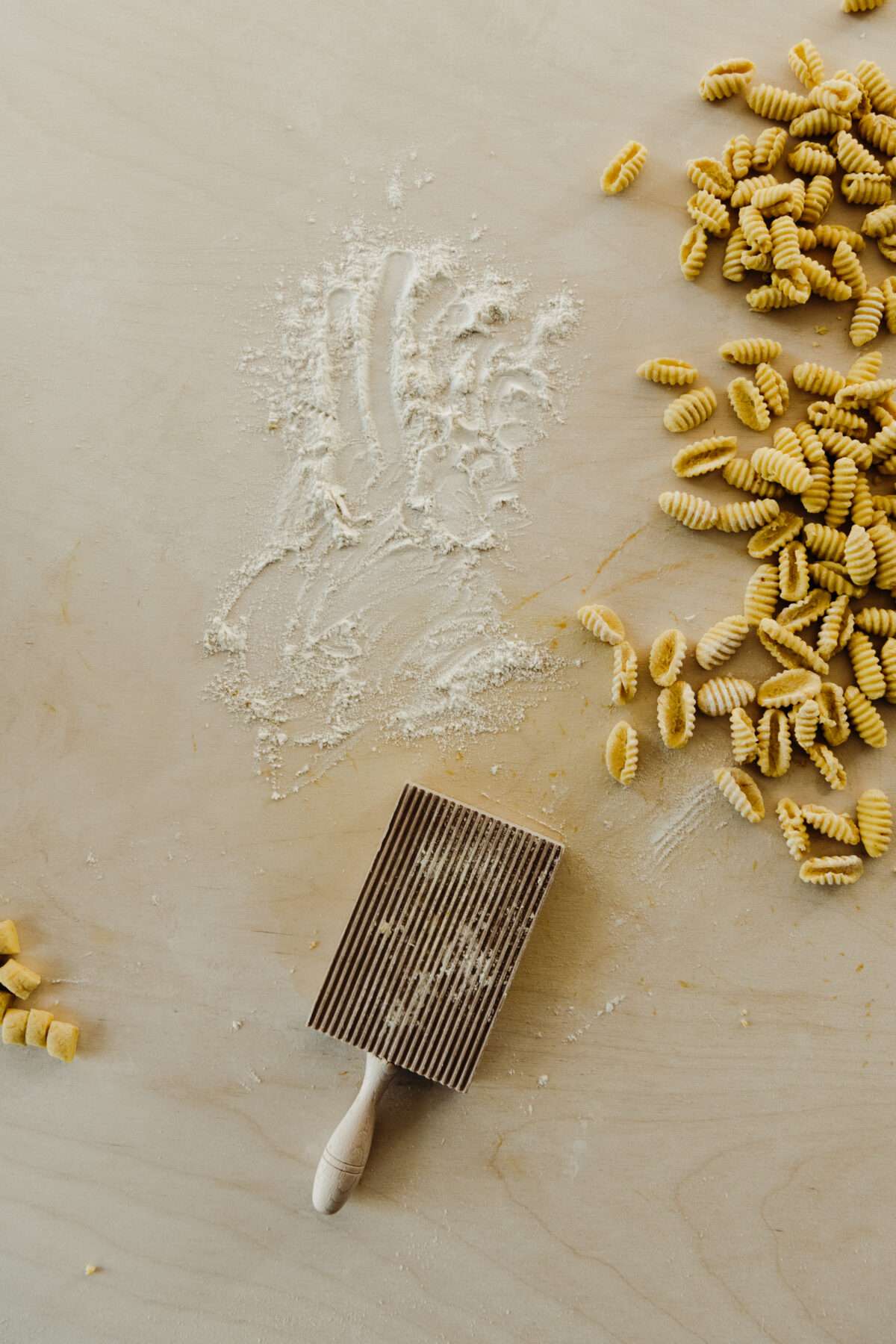
“Malloreddus means “fat little calves” in Sardinian dialect – and the pasta is as cute as the name. They have a small, almost cylindrical ridged form, which works brilliantly with coarse-textured sauces. In appearance, and in eating, they are akin to gnocchi made from pasta dough, though of course they are hollow like shells. You can buy them, but I prefer to make them fresh: it’s the simplest semolina and water dough, sometimes stained golden with a little saffron. To shape them, you will need either a ridged gnocchi paddle, a finely woven basket, or, at a pinch, a table fork. If you don’t fancy making your own, use 200g dried spaghetti, 250g fresh malloreddus or 400g fresh gnocchi.
“Artichokes are my very favourite food. For the last 12 years I have proselytised against Sardinian spiny artichokes (which are indeed incredibly spiny), saying the taste is the same as other artichokes except they cost more and are more painful to handle. This year I ate not only spiny artichokes, but my words: in testing the recipe for this dish for Bocca di Lupo’s delivery service I realised that the Sardinians are right; their spiny artichokes do indeed taste – much – more intense and for many purposes more delicious. Use them for this recipe if you can, or otherwise any other small/medium artichokes you can find.”
Serves four as a starter, two as a mainFor the malloreddus
200g durum wheat semolina
A small pinch of saffron (optional)
100ml water
For the dish
4 spiny, or other medium artichokes, and a lemon for cleaning
8 tbsp extra virgin olive oil
2 garlic cloves, thinly sliced
A good pinch of crushed dried chilli flakes
More lemon – either a quarter of a whole lemon (skin and all) chopped, or the zest and juice of one lemon
A small handful of flat-leaf parsley, chopped
60g grated pecorino Romano
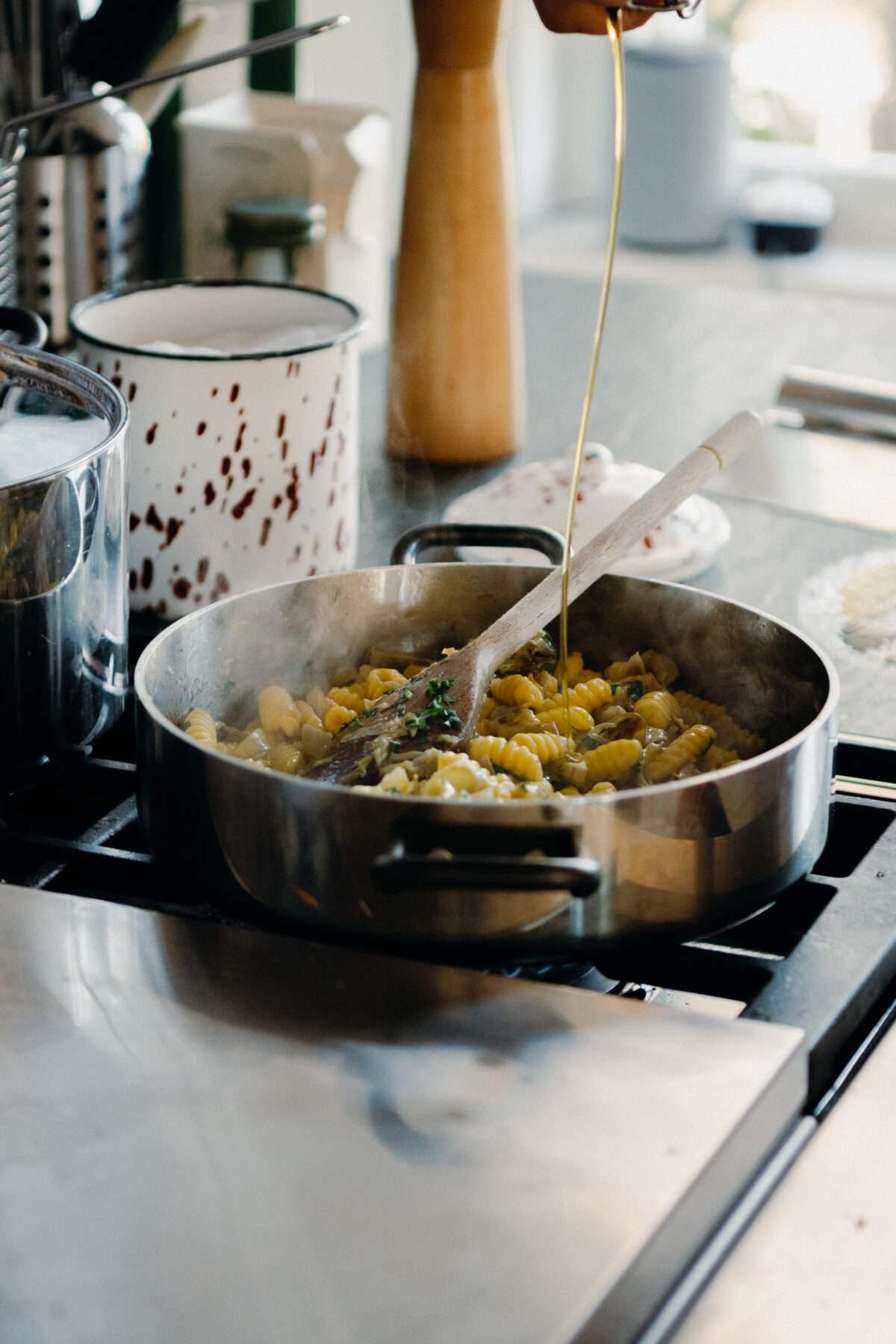
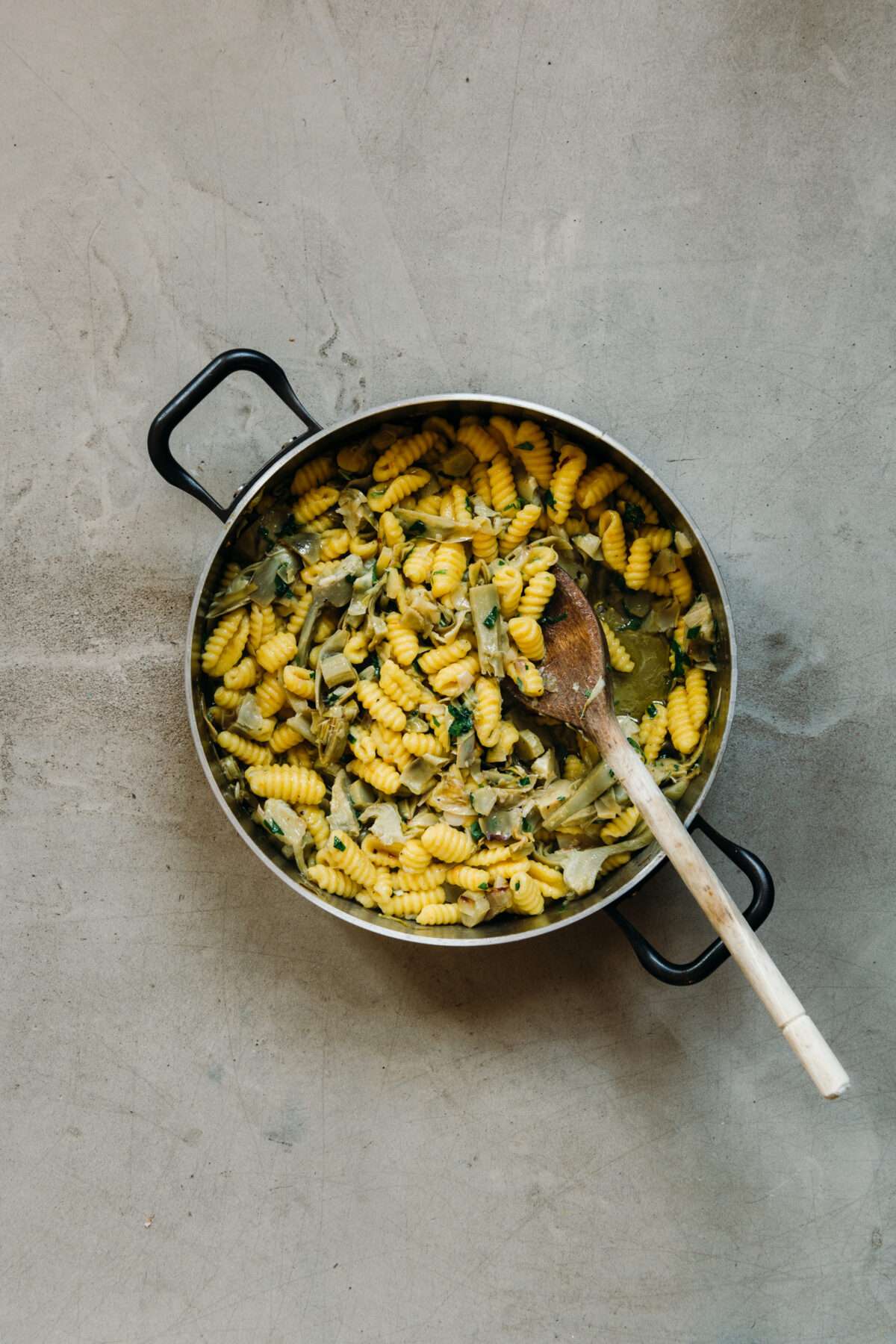
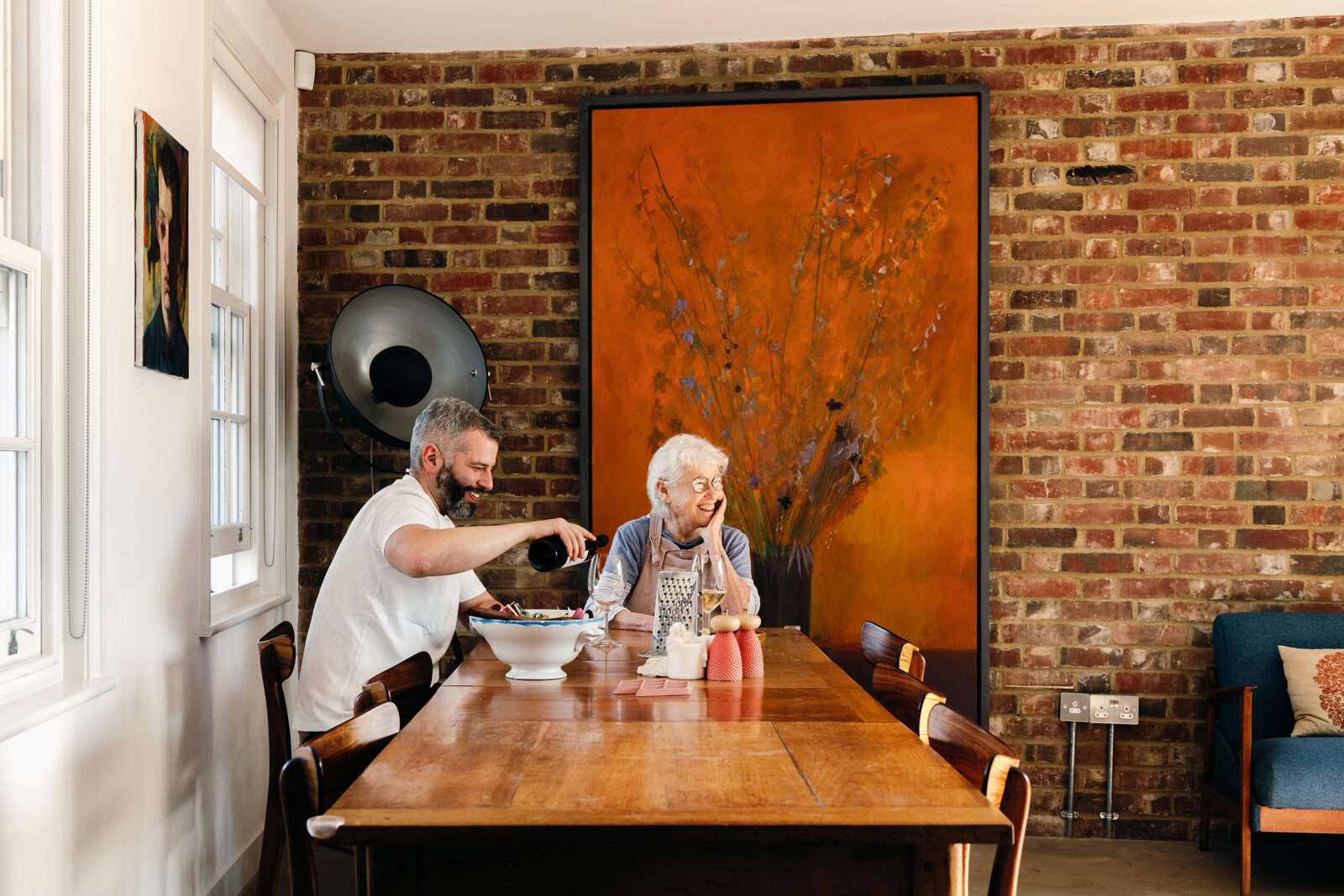
If using saffron, steep it in 100ml of boiling water and leave it to cool for 15 minutes, until it’s hot but not scalding. If you are not using saffron, use 100ml water heated up a little.
Mix the warm water with the semolina and knead well for 10 minutes, then cover and leave to rest at room temperature for half an hour. Break off a chunk of dough and roll into a long strand 1cm wide, or just under. Cut this into 4mm sections.
To turn these into malloreddus, use your thumb and a fair bit of pressure to smear/stretch/roll them along the grooves of something ridged (traditionally, a gnocchi board or finely woven basket). They will curl up around the edge of your thumb as you make them, into little ridged shells.
I quite like them thickish – adjusting the pressure will regulate this – but it’s up to you. However, aim for consistency throughout. They can be cooked straight away or left to dry until slightly leathery, but don’t let them dry out completely, or the magic will evaporate along with the water. You can also freeze them, and cook from frozen.
Clean the artichokes one by one. This is a little tricky, the aim being to remove any tough parts (which will be greenest), and leave any tender parts. It is doubly tricky if the artichokes are spiny ones, but by carefully placing fingers, and using a sharp knife to trim off the spiny parts, you can eliminate the risk of injury.
Start by squeezing one lemon into a tub of water. Take one artichoke, cut off the stem. Trim or snap off the tough outer green leaves until you reach the tender ones within (these will have a yellow or pink hue). Use a paring knife, trim off any green bases of leaves to expose the paler heart. Trim off the tips of the remaining leaves, leaving about 3cm of leaf – they should end up looking like anaemic rosebuds. Keep in the acidulated water whilst you clean the rest.
To make the sauce, halve your artichokes, and check to see if the choke is developed – if it is (bristle-like hairs rather than soft fluff), then trim it out. Slice the artichokes into thin, 5mm wedges and cut the cleaned stalks into 5mm discs (if they feel fibrous under the knife, discard them).
Heat a wide pan over medium heat, then add half the oil, followed immediately by the artichokes and garlic. Fry for a few minutes, then add a splash of water (about 100ml), the lemon (chopped or juice and zest), and the chilli flakes. Season with salt and pepper and braise, covered, over a low heat for 30-40 minutes, regulating the heat and adding splashes of water as you go, so that the pan only dries out and sizzles gently at the end of the cooking time, when the artichokes are melted, soft, condensed and intensely flavoured.
Once the artichokes are cooked, cook the pasta; or set them aside until you’re ready to eat. Fresh malloreddus will only take three to five minutes to cook in boiling, well-salted water. When done to your taste, drain and add them to the hot artichokes along with a good splash of the cooking water, the parsley, and the remaining oil. Sauté, adding water if necessary, until the pasta is coated in a subtle emulsified sauce. Serve immediately, sprinkled with grated pecorino Romano.
Available via delivery from boccadilupoathome.com until the end of March.
